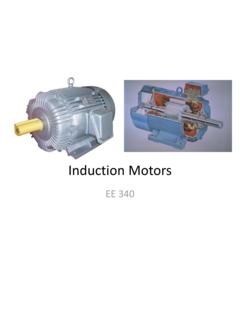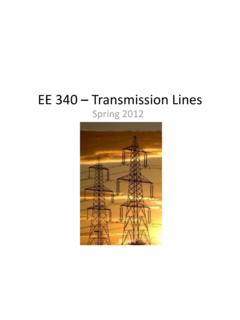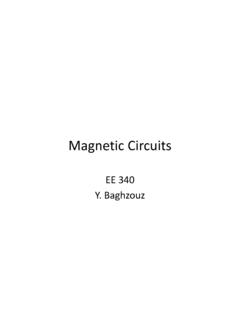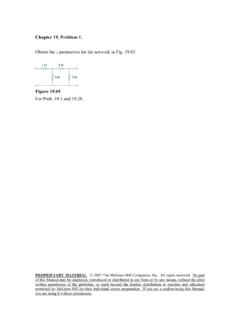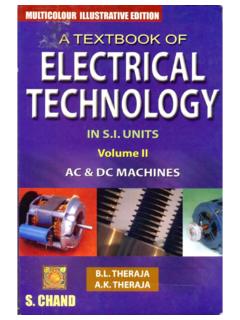Transcription of Synchronous Generator I - UNLV
1 Synchronous generators I. EE 340. Spring 2011. Construction of Synchronous machines In a Synchronous Generator , a DC current is applied to the rotor winding producing a rotor magnetic field. The rotor is then turned by external means producing a rotating magnetic field, which induces a 3-phase voltage within the stator winding. Field windings are the windings producing the main magnetic field (rotor windings armature windings are the windings where the main voltage is induced (stator windings). Construction of Synchronous machines The rotor of a Synchronous machine is a large electromagnet. The magnetic poles can be either salient (sticking out of rotor surface) or non- salient construction. Non-salient-pole rotor: usually two- and four-pole rotors. Salient-pole rotor: four and more poles. Rotors are made laminated to reduce eddy current losses. Construction of Synchronous machines Two common approaches are used to supply a DC current to the field circuits on the rotating rotor: 1.)
2 Supply the DC power from an external DC source to the rotor by means of slip rings and brushes;. 2. Supply the DC power from a special DC power source mounted directly on the shaft of the machine. Slip rings are metal rings completely encircling the shaft of a machine but insulated from it. Graphite-like carbon brushes connected to DC terminals ride on each slip ring supplying DC voltage to field windings. Construction of Synchronous machines On large generators and motors, brushless exciters are used. A brushless exciter is a small AC Generator whose field circuits are mounted on the stator and armature circuits are mounted on the rotor shaft. The exciter Generator 's 3-phase output is rectified to DC by a 3-phase rectifier (mounted on the shaft) and fed into the main DC field circuit. It is possible to adjust the field current on the main machine by controlling the small DC field current of the exciter Generator (located on the stator).
3 Construction of Synchronous machines A brushless exciter: a low 3-phase current is rectified and used to supply the field circuit of the exciter (located on the stator). The output of the exciter's armature circuit (on the rotor) is rectified and used as the field current of the main machine. Construction of Synchronous machines To make the excitation of a Generator completely independent of any external power source, a small pilot exciter is often added to the circuit. The pilot exciter is an AC. Generator with a permanent magnet mounted on the rotor shaft and a 3-phase winding on the stator producing the power for the field circuit of the exciter. Construction of Synchronous machines A rotor of large Synchronous machine with a brushless exciter mounted on the same shaft. Construction of Synchronous machines Exciter Salient poles. Rotation speed of Synchronous Generator By the definition, Synchronous generators produce electricity whose frequency is synchronized with the mechanical rotational speed.
4 P fe nm 120. Where fe is the electrical frequency, Hz;. nm is the rotor speed of the machine, rpm;. p is the number of poles. Steam turbines are most efficient when rotating at high speed;. therefore, to generate 60 Hz, they are usually rotating at 3600. rpm (2-pole). Water turbines are most efficient when rotating at low speeds (200-300 rpm); therefore, they usually turn generators with many poles. The induced voltage in a 3-phase set of coils In three coils, each of NC turns, placed around the rotor magnetic field, the induced in each coil will have the same magnitude and phases differing by 1200: eaa ' (t ) NC m cos mt ebb ' (t ) NC m cos mt 120 . ecc ' (t ) NC m cos mt 240 . Peak voltage: Emax NC m Emax 2 NC f 2 . RMS voltage: EA NC f 2 NC f 2. Internal generated voltage of a Synchronous Generator The magnitude of internal generated voltage induced in a given stator is EA 2 NC f K.
5 Where K is a constant representing the construction of the machine, is flux in it and is its rotation speed. Since flux in the machine depends on the field current through it, the internal generated voltage is a function of the rotor field current. Magnetization curve (open-circuit characteristic) of a Synchronous machine Equivalent circuit of a Synchronous Generator The internally generated voltage in a single phase of a Synchronous machine EA is not usually the voltage appearing at its terminals. It equals to the output voltage V only when there is no armature current in the machine. The reasons that the armature voltage EA is not equal to the output voltage V are: 1. Distortion of the air-gap magnetic field caused by the current flowing in the stator (armature reaction);. 2. Self-inductance of the armature coils;. 3. Resistance of the armature coils;. Equivalent circuit of a Synchronous Generator Armature reaction: When the rotor of a Synchronous Generator is spinning, a voltage EA is induced in its stator.
6 When a load is connected, Lagging a current starts flowing load creating a magnetic field in machine's stator. This stator magnetic field BS. adds to the rotor (main). magnetic field BR affecting the total magnetic field and, therefore, the phase voltage. Equivalent circuit of a Synchronous Generator The load current IA will create a stator magnetic field BS, which will produce the armature reaction voltage Estat. Therefore, the phase voltage will be V EA Estat The net magnetic flux will be Bnet BR BS. Rotor field Stator field Equivalent circuit of a Synchronous Generator Since the armature reaction voltage lags the current by 90 degrees, it can be modeled by Estat jXI A. The phase voltage is then V EA jXI A. However, in addition to armature reactance effect, the stator coil has a self-inductance LA (XA is the corresponding reactance) and the stator has resistance RA.
7 The phase voltage is thus V EA jXI A jX A I A RI A. Equivalent circuit of a Synchronous Generator Often, armature reactance and self- inductance are combined into the Synchronous reactance of the machine: XS X X A. Therefore, the phase voltage is V EA jX S I A RI A. The equivalent circuit of a 3-phase Synchronous Generator is shown. The adjustable resistor Radj controls the field current and, therefore, the rotor magnetic field. Equivalent circuit of a Synchronous Generator A Synchronous Generator can be Y- or -connected: The terminal voltage will be VT 3V for Y VT V for . Equivalent circuit of a Synchronous Generator Since for balanced loads the three phases of a Synchronous Generator are identical except for phase angles, per-phase equivalent circuits are often used. Phasor diagram of a Synchronous Generator (similar to that of a transformer). Since the voltages in a Synchronous Generator are AC voltages, they are usually expressed as phasors.
8 A vector plot of voltages and currents within one phase is called a phasor diagram. A phasor diagram of a Synchronous Generator with a unity power factor (resistive load). Lagging power factor (inductive load): a larger than for leading PF internal generated voltage EA is needed to form the same phase voltage. Leading power factor (capacitive load). Measuring parameters of Synchronous Generator model The three quantities must be determined in order to describe the Generator model: 1. The relationship between field current and flux (and therefore between the field current IF and the internal generated voltage EA);. 2. The Synchronous reactance;. 3. The armature resistance. Open circuit Test The Generator is rotated at the rated speed, all the terminals are disconnected from loads, the field current is set to zero first. Next, the field current is increased in steps and the phase voltage (whish is equal to the internal generated voltage EA since the armature current is zero) is measured.
9 Since the unsaturated core of the machine has a reluctance thousands times lower than the reluctance of the air-gap, the resulting flux increases linearly first. When the saturation is reached, the core reluctance greatly increases causing the flux to increase much slower with the increase of the mmf. Short Circuit Test In here, the Generator is rotated at the rated speed, with the field current is set to zero first, and all the terminals are short- circuited through ammeters. Next, the field current is increased in steps and the armature current IA is measured as the field current is increased. The plot of armature current (or line current) vs. the field current is the short-circuit characteristic (SCC) of the Generator . Short Circuit Test The SCC is a straight line since, for the short-circuited terminals, the magnitude of the armature current is EA. IA.
10 RA2 X S2. The equivalent Generator 's circuit during SC. The resulting phasor diagram Short circuit test An approximate method to determine the Synchronous reactance XS at a given field current: 1. Get the internal generated voltage EA from the OCC at that field current. 2. Get the short-circuit current IA,SC at that field current from the SCC. 3. Find XS from EA. XS . I A, SC. Since the internal machine impedance is EA. ZS R X . 2. A. 2. S X S since X S RA . I A,SC. OCC and SCC. A drawback of this method is that the internal generated voltage EA is measured during the OCC, where the machine can be saturated for large field currents, while the armature current is measured in SCC, where the core is unsaturated. Therefore, this approach is accurate for unsaturated cores only. The approximate value of Synchronous reactance varies with the degree of saturation of the OCC.
